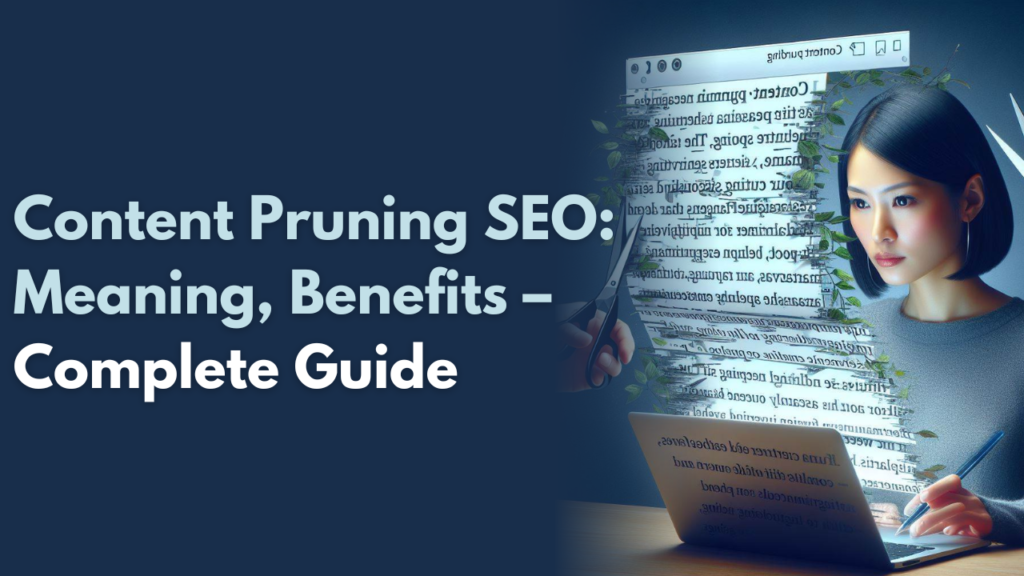Content pruning refers to auditing and revising or removing outdated, redundant, or low-quality content from a website. Like pruning a tree to promote healthier growth and better fruit, content pruning in SEO is done to enhance a website’s overall health and performance. Here’s a detailed look at what content pruning involves, its benefits, and a step-by-step guide on how to execute it effectively.
What is Content Pruning?
Content pruning is the act of systematically reviewing all content on a website to identify and take action on pieces that are no longer beneficial or are potentially harmful to the site’s SEO performance. Actions can include updating, merging, or deleting content.
Benefits of Content Pruning
1. Improved SEO Performance: Removing or consolidating low-quality content can boost the overall authority of your site, helping higher-quality pages to rank better.
2. Enhanced User Experience: By removing outdated or irrelevant content, you ensure a better user experience, making it easier for visitors to find useful and relevant information.
3. Increased Crawl Efficiency: Search engines allocate a crawl budget for each site, which can be wasted on low-value pages. Pruning helps ensure that search engines spend more time on content that matters.
4. Boosts Page Quality: Refreshing old content with updated information and new multimedia elements can significantly enhance the quality and relevance of your pages.
5. Better Content Management: Regular pruning makes it easier to manage your content inventory, helping you understand what types of content perform well and plan future content accordingly.

How to Conduct Content Pruning
Step 1: Audit Your Content
Tools You Can Use: Google Analytics, Google Search Console, Ahrefs, SEMrush.
Metrics to Consider: Page views, bounce rate, conversion rate, backlinks, time on page, and search rankings.
Compile a list of all pages and assess their performance based on these metrics.
Step 2: Categorize Your Content
High-performing: Content that ranks well and drives traffic or conversions.
Underperforming: Pages with low engagement, poor metrics, or outdated information.
Irrelevant or Obsolete: Content that no longer aligns with your business goals or audience needs.
Step 3: Decide the Fate of Each Content Piece
Update: Refresh pages with outdated information but that still hold relevance.
Merge: Combine similar articles or those covering the same topic into a comprehensive single piece.
Delete: Remove pages that are no longer relevant or cannot be salvaged through updates.
Step 4: Implement Changes
Update content based on current information and SEO best practices.
When merging, ensure the new combined content is cohesive and well-optimized.
If deleting content, make sure to redirect URLs to relevant pages to preserve link equity and improve user experience.
Step 5: Monitor Results
Track changes in traffic and rankings after the pruning to measure the impact.
Use tools like Google Analytics and Search Console to continue monitoring the performance.
Step 6: Regularly Schedule Content Reviews
Content pruning should not be a one-time activity. Schedule periodic reviews (e.g., annually or biannually) to keep your content fresh and relevant.

Best Practices for Content Pruning
Use 301 Redirects: When deleting pages, always use 301 redirects to related pages to keep the user experience seamless and preserve SEO value.
Focus on Quality: Make sure updated content is high-quality and aligns with user intent.
Document Changes: Keep a log of what content was changed, merged, or deleted to track the effects of your modifications.
FAQs
What is content pruning?
Content pruning is the process of auditing a website to identify and eliminate or improve pages that are underperforming, outdated, or irrelevant. The goal is to enhance the site’s overall quality and SEO performance.
Why is content pruning important for SEO?
Content pruning helps improve a site’s SEO by eliminating low-quality content that can dilute the site’s overall relevance and authority. This process also helps search engines crawl and index the site more effectively, potentially boosting rankings for remaining high-quality content.
How often should I prune my website content?
The frequency of content pruning depends on the size of your website and the rate at which you produce new content. For most sites, a thorough content audit and pruning process should be conducted at least once a year. However, larger sites or those frequently updating or adding new content might benefit from biannual or quarterly reviews.
What tools can I use for content pruning?
Several tools can help with content auditing, including Google Analytics for traffic analysis, Google Search Console for understanding search performance, and SEO tools like Ahrefs or SEMrush for insights on keywords, backlinks, and competitor performance.
How do I decide which content to delete, update, or merge?
Decide based on data from your audit:
– Delete content that is outdated, irrelevant, or has no strategic value.
– Update content that is still relevant but needs refreshed information or improved SEO.
– Merge content if you have multiple articles on the same topic that could be combined into a single, comprehensive resource.
What should I do with the URLs of deleted content?
Always use 301 redirects for deleted content’s URLs, directing users and search engines to a relevant page on your site. This helps preserve link equity and maintains a good user experience.
Can content pruning hurt my SEO?
If not done correctly, content pruning can negatively impact SEO, especially if you delete pages that have valuable backlinks or still receive significant traffic. Always base your decisions on thorough data analysis and consider updating or merging pages instead of deleting them.
How do I measure the success of content pruning?
Monitor metrics such as organic traffic, ranking positions, bounce rate, and conversion rates before and after the pruning process. Improvement in these areas typically indicates successful content pruning.
What are the best practices for updating content?
When updating content, ensure it is thorough and aligns with current user intent. Update factual information, add new relevant data, and improve readability and SEO. Also, update the publish date to reflect the recent update to let users and search engines know the content is current.
Is there a risk of losing valuable content during the pruning process?
Yes, there’s a risk of inadvertently removing content that could perform well with updates or better SEO optimization. To mitigate this risk, carefully analyze content performance data and consider potential improvements before deciding to delete content.
Conclusion
Content pruning is an essential aspect of maintaining a healthy website and SEO strategy. By regularly evaluating and adjusting your content, you ensure that your site remains relevant, efficient, and valuable to users, thereby enhancing both engagement and search engine rankings.

